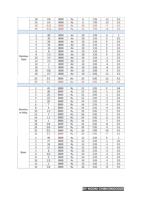
FIBER LASERSTARTER OPERATION KIT
IN THIS MANUAL, YOU WILL FIND THE BASIC OPERATION PARAMETERS FOR
CUTTING AND TROUBLE SHOOTING WHICH WILL HELP IN YOUR DAY TO DAY
MACHINE OPERATION. This will also assist in increasing your cut quality and efficiency
during operation from 500W power source to the 8000W laser power source. Enjoy!
THE AUXILIARY GAS:
Uses:
● Blowing away slag from cutting.
● Cool the metal and reduces the heated zone
● Cooling protective lenses to avoid damage and keep consumables for longer.
● To protect the metal, eg nitrogen protects stainless steel against oxidation
MOST COMMONLY USED GASES ARE OXYGEN, NITROGEN AND HIGH PRESSURE
AIR:
● Oxygen:
○ Mainly for cutting carbon steel as it also oxidises the material being cut when
it reacts with the carbon.
○ It supports combustion and also blows away slag
○ Purity requirements are normally 99.5% or higher.
○ Pressure is required at 0.3-1MPa according to material thickness
● Nitrogen:
○ Mainly for stainless steel, Aluminium and Brass
○ It acts as a suppression gas, not easy to burn and generate slag because it
aids in corrosion resistance.
○ It’s needed in high pressure amounts, therefore can cut at high speeds.
○ It’s the most expensive of the above mentioned gases and it’s also needed in
higher purity and quantity.
○ E.g. cutting stainless steel above 8mm will need 99.999% pure nitrogen with
pressure requirements at about 1.5MPa- 2MPa for 12mm-25mm thicknesses
● Compressed Air:
○ More suitable for thin metal less than 6mm at 8000W.
○ Cheaper than all the above mentioned
1: MORE ABOUT COMPRESSED AIR CUTTING
● More preferred for thin metals (3mm or less for 1000W and ~8mm for 8000W)
○ Brass
○ Steel
○ Galvanised metal
○ Aluminium
BY NGONI CHIBVONGODZE


























